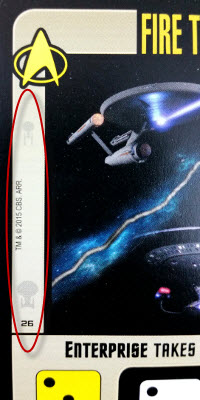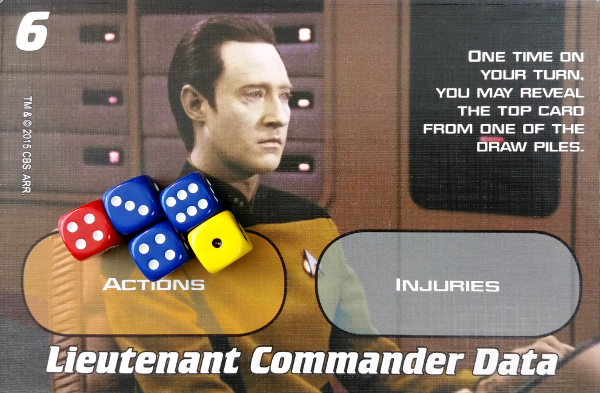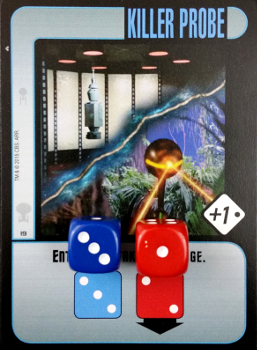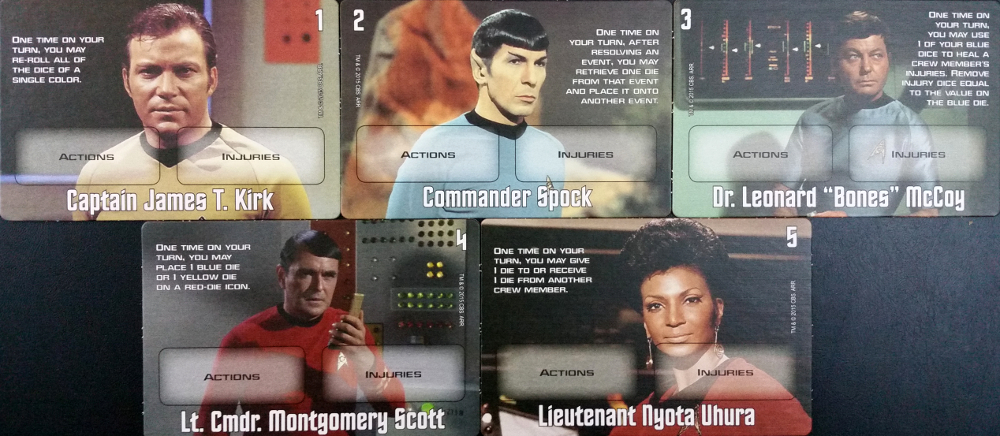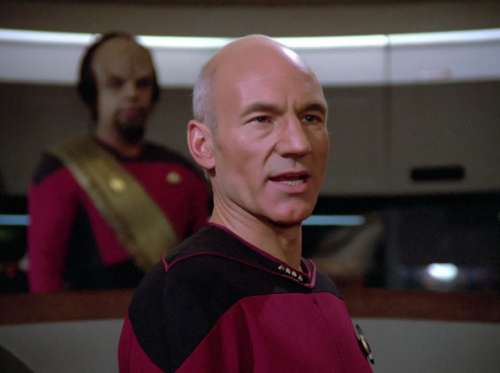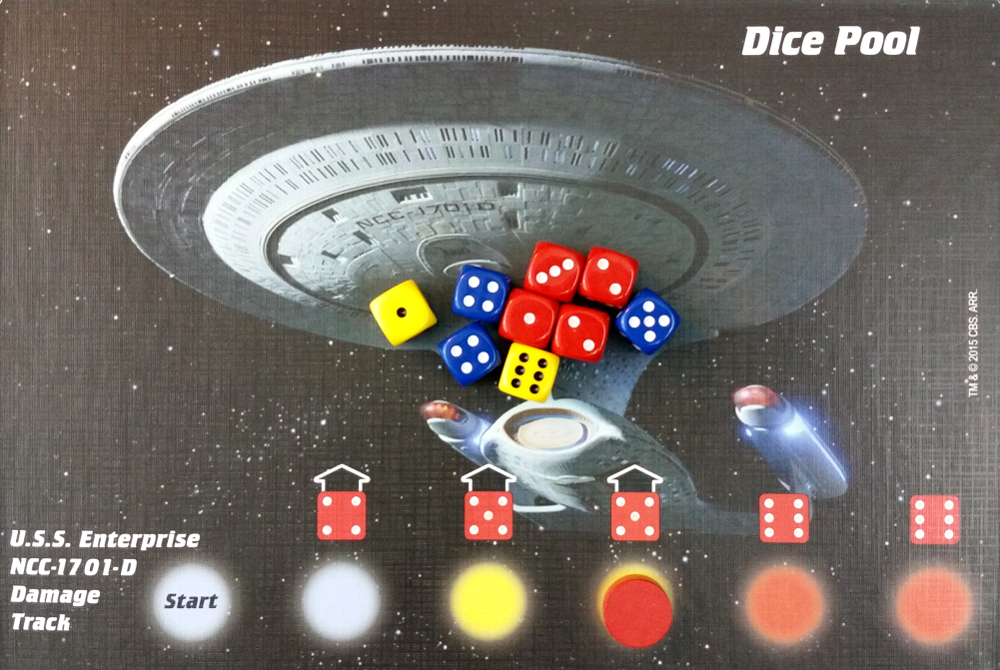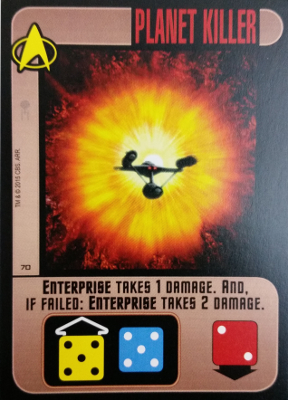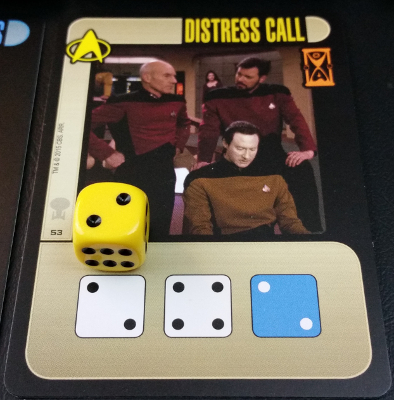“Captain’s Log, Stardate 14981.5. We have arrived at the Whitcher Expanse to continue our search efforts. Long range sensors have picked up a series of ionized tachyon particle emissions throughout the sector. Their source is unknown, though Engineering is adamant that its makeup doesn’t confirm to any known natural phenomenon. Given the vector they are being discovered along and the limited concentration on that route, it very well could be a sign of the missing USS Enterprise, whose last communication had them passing through here not 4 days ago…”
The Premise
All hands on deck! In the futuristic world of Star Trek, humanity has taken to exploring the stars in the hopes of learning more about the universe and our place in it. Such exploration is rife with adversity though. In this game, players choose are crew members aboard the USS Enterprise and must work together to solve enough ship-based events to achieve their mission before their luck runs out.
The Rules
Star Trek: Five-Year Mission is a light Co-Op dice allocation game about players accomplishing missions aboard the USS Enterprise. The game consists almost entirely of three color-coded Alert Decks (Blue, Yellow, and Red) which represent various missions, dice, and a set of Crew boards. However, while quick to set up, the game requires minor preparation before players can boldly go forward.
To start, players first decide whether to use the characters and ship of The Original Series’ Enterprise or those of The Next Generation. Then, each player chooses one of that faction’s seven Crew members. Every character possesses a unique ability that can be used once per turn throughout the game. Next, each Alert deck is constructed based on which ship was selected and placed alongside the central Dice Pool board depicting that Enterprise. Finally, players decide upon the difficulty level they wish to set the game’s victory condition.
At the beginning of the game, each player receives five dice, and the first Blue Alert is revealed. The Captain is the starting player – naturally.
Start Trek: Five Year Mission is played over an indeterminate series of turns, each broken down into three steps. First, the player reveals a new Alert from any deck, with Blue being the easiest to solve and Red the hardest. After resolving any immediate effects, such as the ship taking damage, the player gaining an Injury, or the triggering of another Alert, it is placed below existing Alerts of that color. If a fourth Alert of a color is revealed, the oldest one fails immediately.
Next, the player may take dice from the Dice Pool until they have up to five on their board and rolls them. Each Injury a player has, however, locks a die from being rolled or used.
After that, the player places any number of their non-Injury dice onto Alerts. Every Alert contains one or more dice allocation spots requiring specific die numbers and colors to be completed. Whenever an Alert is completed (or fails), it is removed; dice on them return to the Dice Pool.
Some completed Alerts are simply discarded, while others offer special one-shot abilities to be saved for later use. Most importantly, though, are those with a Star Trek insignia. Those are scoring Alerts, and they count towards winning the game.
Alternatively, a player may allocate Red dice towards repairing the ship, as a damaged ship forces players to choose harder Alerts, or they can skip allocating dice entirely to heal an Injury.
Once all dice are placed and Alerts resolved, it is the next player’s turn.
If players collectively fail five Alerts, or if the ship takes enough damage, the crew loses…as they are likely dead, Jim.
On the other hand, should players score enough Alerts to reach their difficulty level, then their mission is successful. The crew are free to rest, recharge, and get ready to do it all over again in the next episode.
Cardboard Set Pieces
In its 50 year existence, the Star Trek franchise encompasses more than a dozen movies, six TV shows, and countless fans across multiple generations. Beyond its outer space setting, Star Trek’s underlying message ranges from aspiration for a more diverse and inclusive future, to tapping into our ever-instinctual desire to explore, to an allegorical vehicle for the troubles of our times. In this, Star Trek: Five-Year mission had an incredibly deep well of thematic material to draw from.
Unfortunately, this game uses very little of it.
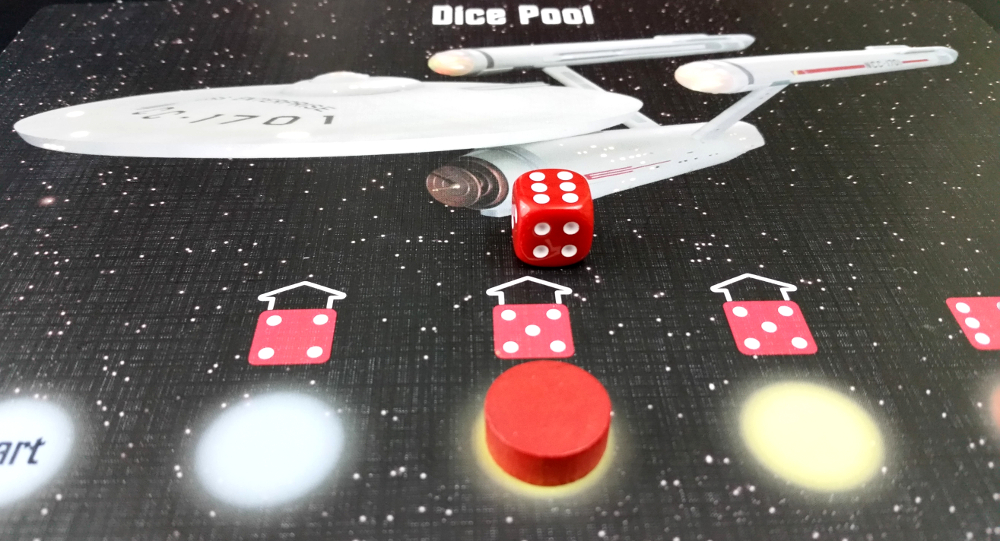
The player chooses to spend a red die to heal the ship, once again allowing the team to draw Blue Alerts
Watching Alert severities increase as you and your ship take damage is a nice thematic flourish, as is the game’s inherent co-op nature. Beyond that, however, and some very loose association between characters and their unique abilities (such as the healing power of the doctors), the theme doesn’t tie-in to the flow or structure of the game.
Moreover, what imagery it does use is not incredibly non-fan friendly. While the Alert cards often have amusing or notable references to iconic show moments via photography stills, that flavor is lost on anyone unfamiliar with the source material.
Case in point: although the game gives equal deference to both Original Series and Next Generation shows through double-sided boards and tailored Alert cards, Five-Year Mission doesn’t even explicitly state which Crew member is part of which series – even though it’s a setup requirement. You have to consult the back of the rulebook to know for sure.
Put all together, Five-Year Mission feels like a light dice allocation game with a hastily or haphazardly pasted premise, which is disappointing. Thematically speaking, the game does a serviceable enough job as to not make it feel completely devoid of flavor or purpose, but only just. Oddly, this makes the ‘Star Trek’ part of of Star Trek: Five-Year Mission is one of the game’s weakest aspects. As a result, don’t expect Immersionists (or die-hard Star Trek fans) to excitedly enlist for this voyage.
Captain’s Orders
One of the most enticing aspects to co-op games is the collaborative nature between players as everyone works to defeat the challenges that the game puts forth. In spite of this, there is often a potential down side in the form of the Alpha Gamer Syndrome. This is when, with everyone on equal footing and a low degree of choices to make, certain personalities can take over as de facto leaders. These players feel the need to solve the game unilaterally, dictating decisions and relegating other players to secondary roles. This can make for unpleasant situations and can quickly take the fun out of the game. Regrettably, Five-Year Mission readily invites this behavior.
Part of the reason for this is, ironically, how easy this game is to learn. With short playthroughs and an easy to follow turn structure, Five-Year Mission is capable of getting upwards of seven people playing in minutes. Aside from some Alert card effects that could benefit from clarification, most of the game is highly intuitive and easy to grasp, making it quite viable for leisure gaming.
What’s more, although it’s not fleshed out well and easily overlooked in the rules, Five-Year Mission has the added benefit of being able to add and drop players on the fly. By simply adding or removing a set number of dice, the game ably scales and adjusts to player fluctuation, making this dice game even more casual-friendly.
The game also tacitly addresses the alpha issue itself through a handful of Communication Failure Alerts, which prevent you from interacting with the other players until it is removed. Whether this only means talking or taken further to include nonverbal queues is ambiguous and thus left up to the players, but we highly encourage the latter to truly sell the effect.
Yet because of the game’s simplistic rules, Five-Year Mission has significant limitations as to what you can do to affect your odds of winning. Barring using your Crew ability or a saved Alert card, turns consists almost exclusively of rolling dice and then seeing where the results fit on the board.
This low degree of complexity may make it very accessible, but like an unwanted energy being, it also leaves plenty of room for someone to start treating the situation like multiplayer solitaire. With only so many choices to make each turn, Five-Year Mission is quite susceptible to the alpha gamer. You’ll want to be careful with your play group. Socializers are going to enjoy this game, but only if you have more Kirk and less Shatner.
The Chase Is On
The other notable attribute of Star Trek Five-Year Mission is how adept it is at adjusting its own difficulty level. Chief among these factors is deciding on how high you want to set the bar among six different challenge goals. At a minimum you’ll need 10 scored Alerts to win, but the highest tier requires twice that.
In addition to Yellow and Red Alerts, Five-Year Mission lobs extra hurdles in the form of Prime Directive Alerts, which require that you solve them before any others, and Urgent Alerts, which demand you complete them within a couple minutes of being revealed – sand timer and all. The combined effect undeniably provides a sense of building tension and impending crisis as the game progresses forward, and it’s not uncommon to reach moments when you have to make judgment calls on where to invest your efforts and your continually fluctuating dice resources.
Despite that, the game’s payoff is uneven. It seems strange to claim that a dice game could simultaneously be heavily random and on rails, but with both linear decision-making and a singular path to victory, Five-Year Mission feels that way at times. Even with a definitive goal, there are few ways to manipulate dice in your favor, so getting to the finish line is largely out of your hands. Strikers: avoid this game entirely, as all you’ll find is frustration.
Curiously, the same can be said of Daredevils, who will find it enticing at first but will eventually feel a distinct lack of gameplay variety. There will definitely be times where gambling on a more challenging Alert or choosing to complete one mission over another is warranted or even necessary, especially at higher difficulty levels, but ultimately they’ll be flummoxed that so much of your choice for the turn is predetermined.
Naturally, this also means that even though there’s a modicum of collaborative decision-making to combat these challenges in any given round, such as which Alerts to focus on or which dice to take from the Dice Pool versus which to leave for the next player, the highly luck-based nature of the game makes it very difficult to plan beyond your current turn, let alone full rounds ahead. In games with four or more players, for instance, it’s possible that the board state could look entirely different by your next turn. This leaves little room for long-term strategy or player growth as your Enterprise crew lurches from one crisis to the next – which is almost fitting. However, when coupled with limited player actions, this is one game both Architects and Tacticians will run away from at warp speed.
The Takeaway
Star Trek: Five-Year Mission may be a mild and passable dice allocation game, but a Star Trek game it is not. Beneath a lightly-applied licensed veneer- one that has little bearing on actual gameplay – lies a basic game where your chances of winning are heavily dictated by the luck of the draw and the randomness of the roll. Decisions are often so direct and self-apparent that it can feel like you’re less controlling a spaceship than you are on a spaceship-themed roller coaster.
That said, the game does a commendable job at being easy to learn and quick to play, and its ability to handle seven players cooperatively while being scalable in difficulty is notable, giving it an extra modicum of replayability. As such, although flawed and doing few things boldly, Star Trek Five-Year Mission is still a light Gateway Game that maintains some merit in casual game settings.
Star Trek: Five-Year Mission is a product of Mayfair Games.
Cardboard Republic Snapshot Scoring (Based on scale of 5):
Artwork: 3
Rules Clarity: 4
Replay Value: 3
Physical Quality: 3
Overall Score: 3
Photo Credits: Star Trek TNG image by Paramount Pictures; Futurama by Comedy Central.

